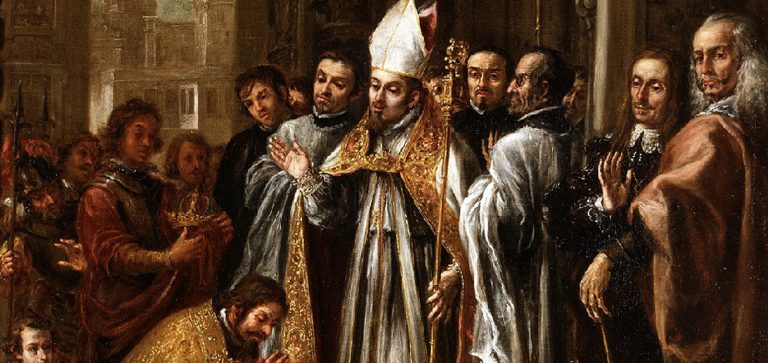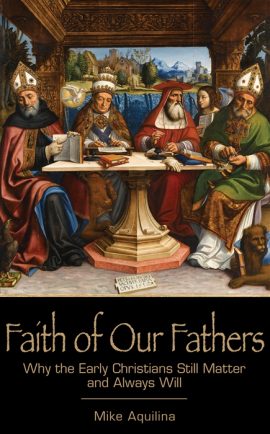By Mike Aquilina
Mike Aquilina is the best-selling author of more than forty books on Catholic history, doctrine, and devotion, including Faith of Our Fathers: Why the Early Christians Still Matter and Always Will.

When we think of “teachers” today, we imagine people working in brick-and-mortar schools—with classrooms, mass-produced books, and very young students segregated by age. But there is little evidence that any such institutions existed in the age of the early Fathers. In those early centuries, persecution would have made such gatherings difficult or impossible.
What’s more, there were no printing presses, so there were no textbooks, no catechisms, no worksheets. Remember, literacy was rare. Classroom schooling was for the privileged few. Yet Christianity was then, as it was in the time of James Joyce, and as it continues to be today: “Here Comes Everybody.”
So we should not think of the Fathers as academics—pondering obscure points of angelology among their fellow scholars. They were primarily pastors, and most of their works represent the Church’s pastoral response to urgent local circumstance.
With no printing presses and no schools, the Church’s ordinary medium was the liturgical assembly. The Fathers did much of their teaching when their people came to Mass.
They aimed their teaching at adults, assuming that parents would pass the Catholic faith on to their children. And they tried to convey the important details in memorable ways—through hymns, for example, or prayers, or poems, or brief slogans.
In the early years, a parish “church” was rarely a dedicated building. The church met for Mass in the homes of believers. Sometimes these homes were decorated with artwork that depicted biblical scenes or images of the martyrs. These images, too, served a catechetical purpose, cultivating a Christian imagination in congregations that could not afford the luxury of literacy.
The heart of the early Fathers’ teaching was the so-called “rule of faith,” a brief, creed-like summary of doctrine. Though the wording varied from place to place, the formulas were remarkably consistent in content. They proclaimed that God became man in Jesus Christ, whose life had been foretold by the prophets; and that Christ died, rose from the dead, and is now glorified. Eventually, these formulas developed into the uniform baptismal creeds that we recite even today.
Baptisms took place at Easter, and the run-up to Holy Week was a time of intensive teaching addressed especially to newcomers to the practice of the Faith. The Fathers used the most basic touchstones as their course outlines. They would walk petition by petition through the Our Father, article by article through the Creed, commandment by commandment through the Decalogue. Remarkably, they conveyed a constant sense of the divine origin of the doctrine, even as they spoke frankly of its practical consequences for everyday living.
At the same time, most of the Fathers observed a scrupulous silence regarding sacramental doctrine. Today we call this practice the “discipline of the secret.” Those who were not yet baptized were not allowed to attend the sacramental rites. To go to Mass was to enter the holy of holies—the place of God’s presence—and this was reserved for Jesus Christ, the Son of God, and all those who had come to share His life through baptism.
Catechesis of new Christians after baptism focused on the sacramental rites, walking through them step by step and explaining the meaning of the symbols, the words, the postures and gestures. This sort of teaching is known as mystagogy, or guidance in the mysteries, pedagogy for the hidden things.
Mystagogy was perhaps the most crucial phase of catechesis for the Fathers. Sacramental communion was the goal—the earthly foretaste of heavenly glory that made sense of the Church’s moral teaching. Though moral teaching often preceded mystagogy, the sacramental teaching brought it to a certain completion. The last material in completion was the first in intention. For the Fathers, the moral law was ordered to the liturgy. The Fathers taught their people to live their lives in a way that disposed each of them to the fullness of divine love.
The Church’s magisterium has recently urged us all to take up this task once again, and learn from the Fathers, and revive the practice of mystagogy in the Church—not just for new Christians, but for all. This call is stated most urgently in Pope Benedict XVI’s Sacramentum Caritatis and in the Catechism of the Catholic Church.
The Fathers are thus, once again, excellent models and timely witnesses for us. The fourth-century pilgrim Egeria tells us that when St. Cyril of Jerusalem delivered his mystagogical sermons, his listeners regularly interrupted him with thunderous applause. Surely the same was true in the churches of the other great mystagogues whose sermons have come down to us: Ambrose, Chrysostom, Augustine, and Theodore of Mopsusestia. If we read them today, we can understand why.
You Might Also Like
 Getting to know the Church Fathers means getting to know our own roots. It means knowing more deeply who we are as we learn more and more about who they are. The early Christians are our ancestors, our common genealogy, our family. Learn more in popular author Mike Aquilina's Faith of Our Fathers: Why the Early Christians Still Matter and Always Will.
Getting to know the Church Fathers means getting to know our own roots. It means knowing more deeply who we are as we learn more and more about who they are. The early Christians are our ancestors, our common genealogy, our family. Learn more in popular author Mike Aquilina's Faith of Our Fathers: Why the Early Christians Still Matter and Always Will.

